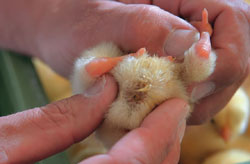



Preventing Omphalitis to Reduce First Week Mortality
Causes of navel-yolk sac infection (also known as 'mushy chick disease' and 'navel ill') and advice on its prevention by Gerd de Lange of Pas Reform.A major cause of increased first-week chick mortality is omphalitis, or navel-yolk sac infection: a hatchery-born disease also known as ‘mushy chick disease’ and ‘navel ill’.
 |
Various bacteria may be involved, such as coliforms, Staphylococcus, Streptococcus and Proteus. Mortality usually begins within 24 hours of the hatch and peaks by five to seven days. Mortality levels of five to 10 per cent are not uncommon, making omphalitis a significant – and largely preventable – challenge to post-hatch performance.
Affected chicks appear depressed with drooping heads. Post mortem examination reveals discolouration around the navel and an inflamed yolk sac with distended blood vessels, together with an offensive odour. The chicks feel ‘mushy’, indicating the presence of subcutaneous oedema.
For omphalitis to occur, causative bacteria and a route of entry into the yolk sac must be present.
Chicks are not born into a sterile environment. The likelihood of omphalitis developing is much higher in a batch of eggs that includes bangers, or if the hatcher baskets are not thoroughly cleaned and disinfected prior to transfer. Infection pressures can be effectively reduced by good hygiene practice.
With optimal incubation, chicks will normally hatch with properly healed navels. In some cases, although the navel may be slightly open at hatching, it should close naturally within a couple of hours, while the chicks are drying. In this scenario, the incidence of omphalitis is minimal.
However, if the navel shows any deformity, it creates a point of entry for bacteria. Nutrients in the yolk combined with the body temperature of the chick will produce rapid bacterial multiplication. Maternally derived immunity will not offer sufficient protection against this invasive challenge while the chick’s own immune system is still immature.
There can be several reasons for increased incidence of navel deformity. ‘Black button’ navels are caused by incubation temperatures being set too high, especially during the last days of the cycle. Temperatures that are too low during the final days of incubation will produce poorly closed navels.
Overly high humidity during incubation results in insufficient weight loss. As a result, the residual yolk sac becomes enlarged, which prevents the navel from closing properly. Conversely, when humidity is too low, the yolk sac dehydrates and becomes hard, which can damage sensitive tissue around the navel.
When eggs are stored for prolonged periods prior to incubation, more chicks with black scab navels are observed, indicating unhealed navels at the moment of hatching.
The standard use of antibiotics to prevent omphalitis is not a sustainable solution and should be discouraged.
Advice
- Maintain thorough hygiene, from laying nest to setter, to minimise the incidence of contaminated eggs.
- Avoid eggs becoming wet, e.g. by sweating, as this results in bacterial penetration.
- Clean and disinfect setters and hatchers, trays and baskets, transfer equipment etc. thoroughly after every use.
- Ensure hatcher baskets are completely dry before transfer, to minimise the risk of bacterial penetration through the pores.
- Consider fumigating the hatcher after transfer if a batch of eggs contains ‘bangers’.
- Aim to produce day old chicks without navel deformities by optimising incubation conditions that take breed, maternal age and duration of storage into consideration.
- Target the narrowest hatch window possible – and do not pull chicks while some are still wet, as these are still likely to have slightly unclosed navels.
- Handle chicks under optimal climatic conditions from the moment of pulling until their placement on the farm, to avoid chilling or overheating, as either will be detrimental to the chicks’ immune status and yolk sac resorption.
- Stimulate feed intake as soon as the chicks arrive at the farm, to accelerate yolk sac resorption.
July 2011








